Library Resource Sharing and Discovery: Catalogues for the 21st Century
This article is supplementary to the issue 23 report on the CLUMPS event at Goldsmiths College in March this year, and perhaps should be read in conjunction with both that report and Peter Stubley’s article on ‘What have the CLUMPS ever done for us?’ in the same issue. Details of presentations which were broadly similar to those given at Goldsmiths are not repeated here, but can be found in the Ariadne 23 report.
Ariadne made the trip to the north a few days before the conference, so by the day of the event was thoroughly acclimatised for the weather. Grey skies, some rain, but not too windy. Took the underground (the ‘Clockwork Orange’) to Hillhead, and was quickly no more than five minutes’ walk away from the University’s precincts. The trains are on the dinky side, in comparison with other metro railways (hence the clockwork part of the nickname), but sound and feel like a proper underground system. This being Ariadne’s first experience of the Glasgow underground, the width of the platforms between the tracks was unnerving: no more than eight feet or so, from edge to edge, with no safety barriers. Which works out at four feet each for the public travelling in each direction. Ariadne moved along the platform with caution, trying to imagine how Saturday night revellers would cope with this, and decided that they probably took the bus instead.
The Boyd-Orr Building is a fairly typical example of mid-1970’s architecture in Scottish Universities: a tower design, to get the maximum teaching space out of expensive urban land; rubberised flooring to soften a concrete floor (economy), plus cattle sized industrial strength lifts to stop the staff and students having heart-attacks on their way up the stairs to the 9th floor seminar. In Edinburgh, the Appleton Tower with its prairie of rubber on the entrance hall floor, and also the David Hume Tower, used to (perhaps still do) admit horrendous drafts - as well as rain - through ill-fitting windows (of which there were many); but it was not very windy on this Glasgow day, and Ariadne could not tell if the Boyd-Orr Building had the same problems. Historically however it used to have another wind problem, mentioned later in this report.

Addressing University Priorities: CLUMPed or Free Text Searching?
Mark Denham of the CAIRNS Project was the chair for the morning sessions. Ian Mowat, Librarian to the University of Edinburgh, gave the keynote address of the day, ‘Shall Clumps match university library priorities?’ He was obviously concerned that some of the audience might have heard his views before: in this regard he quoted a famous true story concerning the third member of a famous Scottish academic cum medical dynasty, the Munros. Munro Tertius began a lecture in 1824 by reading from his grandfather’s notes, which was his usual practice. On the day in question Tertius began with the phrase ‘when I was a student in Leyden in 1718…’ which understandably resulted in uproar on the benches. Mowat is a member of a JISC committee and is also on the advisory boards for CAIRNS and Riding, and so has aired his views to the eLib community before. However there were many non-eLib faces in the audience for this meeting, so for many, as for Ariadne, these views were heard for the first time.

He briefly outlined the background of the CLUMPS programme: it was part of the 2nd phase of eLib, and this phase was supposed to learn from the experience of parts of the 1st phase. It also set out to explore moving towards delivering a service - essentially to find out what it was like. CLUMPS projects were set up to allow the possibility of wider access - access to more than the user’s host library. CLUMPS have explored various alternatives, such as subject versus geographical approaches (three of the clumps are geographically based, and there is one subject clump).The definition of ‘CLUMP’ was also explored. In the dictionary, the original term refers to trees, shrubs. Mowat developed the metaphor: these objects don’t have to be the same species, he argued, but one might expect the clumped trees and shrubs to be of broadly the same genus.
CLUMPS are a technical solution to a perceived problem, using Z39.50 technology. Beyond that, there was, at the time of the inception of the programme, the feeling that it was a positive move towards service delivery. It was also about the complex institutional politics that go towards developing a service. Looking at the service side of the programme, he pointed out that in the ‘real world’ of the user, every user is a member of several CLUMPS. The programme aimed at trying to bring order and definition to the issue of developing services, but, he argued, if we are not careful, the CLUMPS groups might become unhelpful - users might want access to another CLUMP elsewhere. Ariadne understood this to mean that the advantages of grouping might be undone by users wanting access to differently CLUMPed resources elsewhere - resources essentially of a different genus.
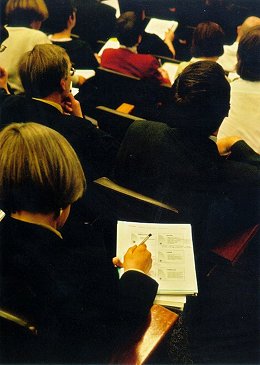
Mowat briefly looked at the lessons learned from CLUMPS in the areas of access, lending, ILL, and membership. Lots of registrations have taken place for the CLUMPs lending facilities. The technology has helped by making virtual access easier, and by showing how physical access might be had. However the Scottish Library Group has not taken forward CLUMPS idea for purposes of ILL (Mowat chairs the Group). Dennis Nicholson has urged this, but it hasn’t happened yet. Mowat argued that ‘a feeling of membership is really what it is about’. The feedback from the Riding project is that ILL has been improved as a result of the project: however his own feeling is that the ILL world is moving so fast that these prototype services will be an irrelevance, since so much happening, and so fast. The future for CLUMPS technology is as intra-library loans, rather than ILL.
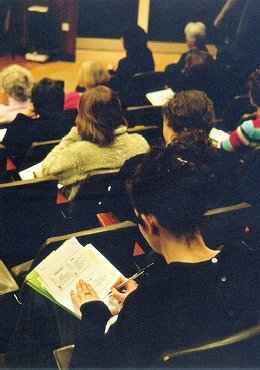
The CLUMPS lessons are important also in that they are useful for the JISC/CEI (Committee for Electronic Information) in determining where we go from here. Mowat remains unconvinced about the National Union Catalogue as a proposal, since no-one has put pen to paper to explain what these catalogues are for. We (the HE community, the users) have different needs at different times. The nation (in this context) doesn’t mean much, and is a carry over from the idea of the nation state. There is a role in the wider international context - but it is, maybe, best to scale up from a national catalogue to a global catalogue. These questions have not been asked. CLUMPS have raised questions about how you do it; and whether to use a physical or a virtual catalogue. His gut feeling is that the experience of the CLUMPS has suggested that Z39.50 is not the ideal solution. It may be that there is technology in development which serves the purpose better. But these technical developments are in the same position today as was z39.50 when we thought it was the solution.
OCLC has 43 million items in its database - which means that the single physical entity model is a practical one. But OCLC has problems with the updating of the entries in this database. A CLUMP of CLUMPS approach is conceivably better in terms of keeping a large database of records up to date. But he is of the view that it is a big question as to whether catalogues will be necessary in future: the power of search engines is so powerful that free text searching may be as quick as metadata searching (this argument generally put to him by colleagues from a computing service background).
Ariadne was surprised at this view, since it seems to discount the value of structured information as opposed to raw data. There is in Lewis Carroll a passage known as ‘The Paradox of the Complete Map,’ which is of relevance here (Sylvie and Bruno Concluded, 1893: see note [1]). Some mapmakers are represented as deciding that the most accurate map of territory is the territory itself. But the problem with this is that the definition ‘accurate’ doesn’t address the usefulness (or otherwise) of the map to the user. Whereas something more subjective and tailored - structured information - might be of more navigational use. This ‘structured information’ v ‘free text searching’ (the map v the territory) dispute has been running for some time, and will continue to run as long as the annual increase in processing power continues.
The usefulness to the user is critically important in the design of services: however it is not always clear at the outset what ‘useful’ is or how it might be defined. Ian Mowat mentioned the first days of the Boyd-Orr building, in which it was discovered that, on windy days, the architectural design funnelled air through the front doors so effectively that some of the students were propelled towards the ‘out’ doors on the other side of the building, without the benefit of the lectures which were supposed to be attended somewhere in between. The situation did not improve until a suitably placed wall was constructed to help the students stay in the building.
Other Views
Matthew Dovey spoke twice during the day: both times on Z39.50 related issues. During the first of these presentations he introduced the concept of the ‘Mega-Clump’. Ariadne checked this over lunch with him since there was the possibility that Ariadne misheard ‘mega-clump’ for ‘meta-clump’ at the Goldsmiths event. It turned out that this was not the case: however Ariadne is still adrift with respect to the development of the terminology in this field.
John Gilby spoke for the M25 project. They have a vision for easier resource discovery, and are ‘doing stuff’ on interoperability (or will be) with UKOLN. Fraser Nicolaides spoke on evaluation issues in the project, using the same powerpoint as John Gilby. M25 has been using four lots of focus groups, and they have been looking at the usefulness (perceived needs) and the structure and appearance of the user interface. This has resulted in detailed amendment of the interface. Most of the changes which were required were organisational (i.e. access to libraries questions, and ILL). These are essentially questions beyond the actual scope of the M25 Link project, but are questions which have to be addressed if M25 Link is to become a service. Services ought to have a user-centric perspective. An example of the kind of problem they had in mind was given: searches on the author Graham Greene - four versions of the name used in searches will return records of some sort, but no individual search will return all. A user-centric interface has somehow to cope with this kind of problem. Community Profiles were also discussed, as before at Goldsmiths. 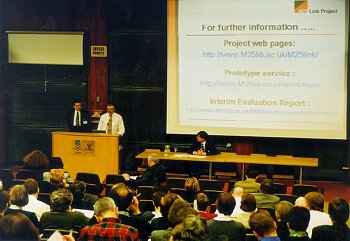
Dennis Nicholson took friendly issue with Ian Mowat’s view, expressed earlier in the day, that metadata might not be necessary - his view is that not only is it necessary, but it is essential. Speed of search is an illusion - CAIRNS has struggled with this perception which tends to come from the computing side of things. The issue needs to be addressed. Dennis’s CAIRNS talk looked at three areas, which were: visions/issues/Pathways. CAIRNS aims at a distributed union catalogue with a single user interface, allowing users to search clumps of servers, using server based dynamic clumping. The project was aimed at creating a union catalogue for Scottish Higher education without the cost and effort of setting up and maintaining a central database. They wanted it to integrate these with access to other clumps.Other issues addressed by the CAIRNS project include - ILL; authentication, distributed approach to serials (i.e., SALSER). CAIRNS currently has 13 databases - not big enough to justify the mechanisms which it uses, but it is assumed it will become bigger.
Lunch! Internet Café!

Lunch was available in a cafeteria a short walk away. It was grey and windy day, but fortunately the local elements were not out to show what they are made of. The buffet lunch was tasty and fine. Ariadne was engaged for the whole of the lunch in a discussion about the current redundancy of overlapping and equivocal terms relating to digital libraries, many of which have the strength and resilience of herbicide resistant weeds.
The Internet Cafe was set up in a fairly small lab rather than the spacious layout at Goldsmiths, and furthermore was on the sixth floor of the windy tower (we used the lift). Lunch and the Cafe were split into two sessions therefore, in order to avoid overcrowding (attendees were given different colours of ticket on arrival). The machines were set up for the demonstration of the CLUMPS gateways rather than any more flexible use (i.e., email), but a resourceful person associated with CAIRNS soon found a way of invoking telnet sessions :-).
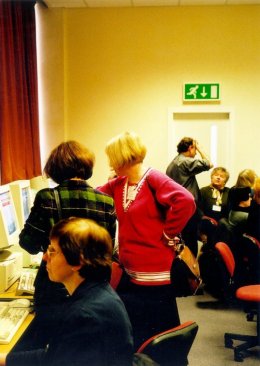
Summary Address
Richard Heseltine, who is on the advisory committee for the RIDING project, was invited to give the summary address for this meeting. He performed the same service for the CLUMPS meeting held in 1999 in the St Pancras British Library building. He argued that what was wanted was a certain openness - being able to search across a range of resources which are not predetermined. Richard recalled that many years before he worked for the SCOLCAP project in the early eighties, and that it bore similarities to current efforts. One of its problems was that all of it was proprietary (i.e., not interoperable). There was then no z39.50, and there were no common standards. Now we have some standards, but there are problems because of the variety of z39.50 implementations, and profiles. In addition, Web browsers create problems because of their inherent statelessness, and cataloguing standards differ between institutions. Richard referred to a remark of Matthew Dovey’s that the Web browser may not be the most appropriate means of accessing information from multiple target databases, and Richard asked if perhaps the Bath profile was intended to address this issue. Originally the benefit of z39.50 was using the interface with which you were familiar to search another database, and then it became the searching of several databases - the origin of the problems we are now experiencing.
Richard then turned to the issue of the CLUMPS. What are CLUMPS for? Everybody agrees that they have to supply services. But the Jury is still out. On the question of access, he noted that CLUMPS have stimulated reciprocal borrowing arrangements. But these developments should not be exaggerated: in Yorkshire for example, Leeds University stopped CLUMPing for borrowing. As far as ILL is concerned, it is still too early to tell. He was hopeful that the CLUMPS will improve access to books. And mused that perhaps we might see the return of van services! He felt that the CLUMPS will survive as resource discovery options and access rights. He thought that they might transform into something else, here referring to Dennis Nicholson’s contribution earlier in the day, when he described the CAIRNS/ SCONE vision for a cross-sectoral Scottish distributed catalogue and, in particular, the idea of using the catalogue records of the National Library of Scotland database to tackle interoperability problems associated with legacy metadata. This, he thought, sounded suspiciously like SCOLCAP reborn.
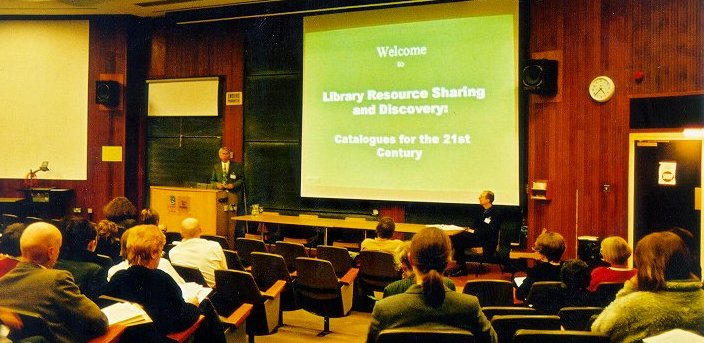
The providers of resource discovery (covering bibliographic info) have an important role to play. But organisational integration (referring to Ian Mowat’s contribution earlier in the day) - needs to be embedded in institutional structures: there needs to be a cross-sectorality. There is currently a great growth in part-time learning - VCLOPS for example - CAIRNS might underpin something like this, and the organisational integration of the CLUMPS as a whole might be institutionally embedded as part of these developments (Richard referred to the 7⁄99 JISC call). He repeated a view Ariadne first heard from him at the UKOLN conference in 1998: that there should be more integration of learning and working environments. Richard agreed with Ian Mowat that he was not clear about what a National Union Catalogue is, or is for, but was of the opinion that, whatever it is, it will be created. He expressed the view that it will be a monument to cataloguers, however, and not the end users. Richard then made a few remarks on the current organisational and institutional environment for CLUMPS type projects, and its suitability as an infrastructure for the development of services.
Richard concluded by referring to the recent appointment of Lynne Brindley as Director of the British Library as a very positive development, and hoped that in future it might be possible to talk of the ‘Electronic British Library’.
References
- ‘That’s another thing we’ve learned from vour Nation.’ said Mein Herr. “map-making.” But we’ve carried it much further than you. What do you consider the largest map that would be really useful ?’ ‘About six inches to the mile.’ ‘Only six inches!’ exclaimed Mein Herr. ‘We very soon got to six yards to the mile. Then we tried a hundred yards to the mile. And then came the grandest idea of all! We actually made a map of the country, on the scale of a mile to the mile!’ ‘Have vou used it much ?’ I enquired. ‘It has never been spread out, yet.’ said Mein Herr: ‘the farmers objected: they said it would cover the whole country, and shut out the sunlight! So we now use the country itself, as its own map, and I assure you it does nearly as well.’
From Sylvie and Bruno Concluded, by Lewis Carroll, 1893. At: http://www.hoboes.com/html/FireBlade/Carroll/Sylvie/ - Information about the programme for each of the two CLUMPS conferences is at: http://www.ukoln.ac.uk/events/elib-clumps-2000/
- CLUMPS projects can be accessed via the eLib Programme Projects page: http://ukoln.ac.uk/services/elib/projects/
- ‘Catalogues for the Twenty-first Century?’ A report on the Goldsmiths conference on the 3rd March 2000.
- Peter Stubley’s article What have the CLUMPS ever done for us?, delivered to to the ‘Catalogues for the Twenty-first Century?’ conference at Goldsmiths, is available in Ariadne issue 23.
- Peter Stubley’s ‘Clumps as Catalogues: virtual success or failure?’ looks at the state of of parallel searching with Z39.50, and was published in Ariadne issue 22: http://www.ariadne.ac.uk/issue22/distributed/distukcat2.html
- Matthew Dovey’s ‘So you want to build a union catalogue?’: http://www.ariadne.ac.uk/issue23/dovey/intro.html
Author Details
| Ariadne UKOLN University of Bath Email: ariadne@ukoln.ac.uk |
